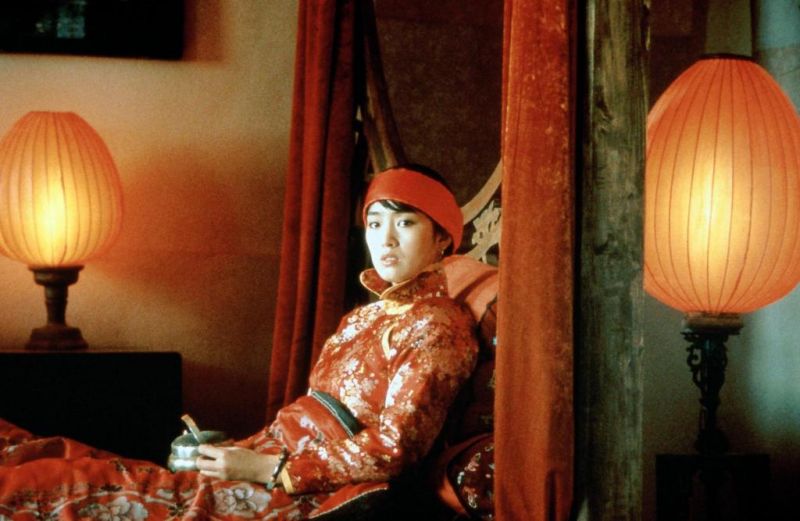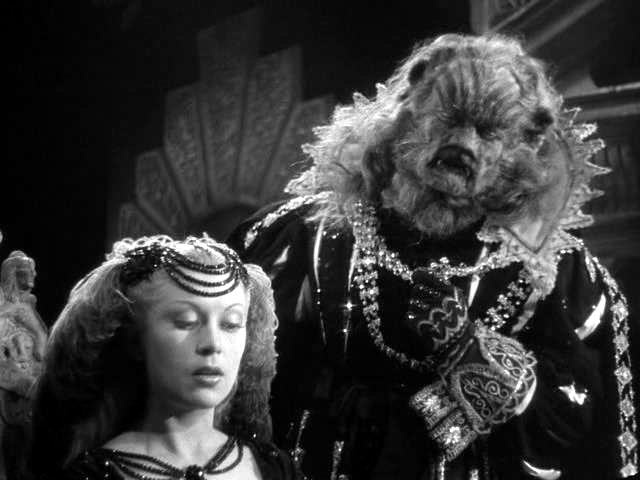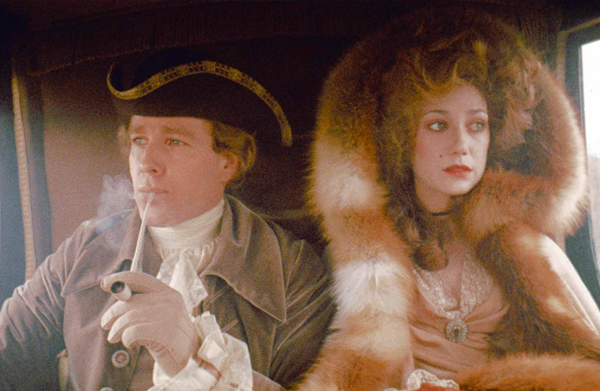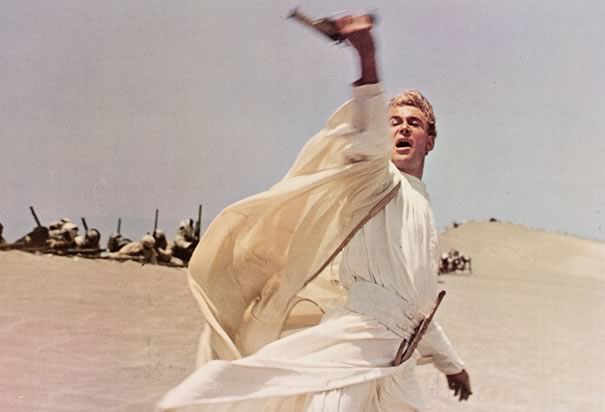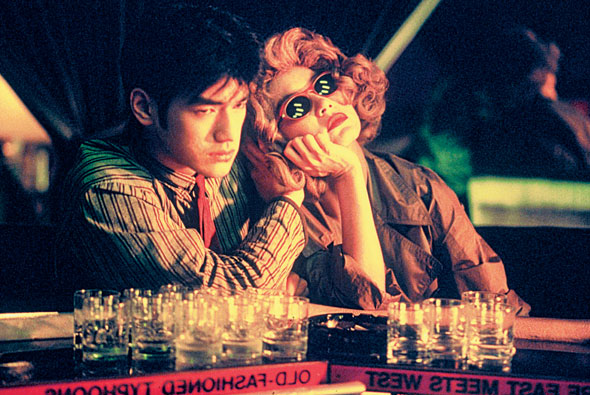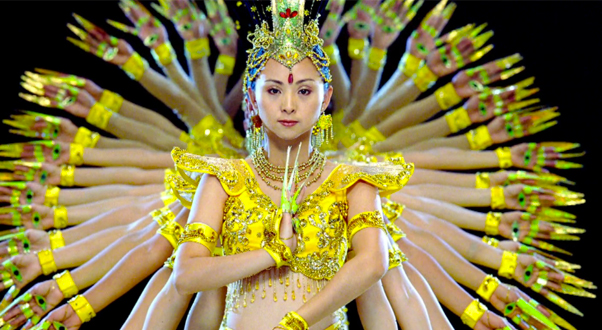7. Zhang Yimou
Most noteworthy examples: Ju Dou, Raise The Red Lantern & Hero
Zhang Yimou’s directorial debut, Red Sorghum, already announced the arrival of a director who was a master of the use of colour but it was his second feature Ju Dou, which went all out and gained him widespread international recognition. Set in a silk dying shop, Yimou used the surroundings to fill the screen with an explosion of sumptuous colours and voluptuous visual flair.
He followed up Ju Dou with Raise the Red Lantern, another film which dazzled with its lush colour scheme and grand visual style, making the director an art house favourite of the early nineties.
Zhang Yimou kept making art house fare for the next decade before re-inventing himself with the stunning Hero, a mix between martial art fantasy and dazzling visual bravura, shot by the amazing Christopher Doyle, another cinematographer who has collaborated with more than one director on this list. The film became a worldwide sensation and was followed by two less successful but nonetheless equally stunning works: House of Flying Daggers and Curse of the Golden Flower.
6. Jean Cocteau
Most noteworthy examples: The Blood of a Poet, Beauty and the Beast & Orphee
If ever there was a director who can be labelled as a true visual poet, it would have to be Jean Cocteau. Unsurprisingly, the man actually was a poet, designer, painter and basically all-round artist before he ever even started directing.
All his movies have an amazing hypnagogic quality to them and seem to float off the screen. His first film inspired by the Orpheus myth, The Blood of a Poet, examines the creative process and the poet’s relation to death in a dreamlike, bordering on purely surreal fashion. But it was his next film, Beauty and the Beast, which truly was a visual marvel from start to finish. Filled with atmospheric romantic imagery, impressive special effects for the time and fantastic costume and set design, the movie is a stunning visual representation of the well known fairy tale and still the best interpretation of the story ever filmed.
Four years later the director would return to the Orpheus myth once again with Orphee, his surreal dream-like masterpiece, shot in crisp black and white photography. A true visual poem if ever there was one, the film was another ethereal and surreal masterpiece, which almost constitutes a genre of its own as there are hardly any other films you could compare this movie with (other than Cocteau’s other works perhaps).
5. Stanley Kubrick
Most noteworthy examples: 2001, Barry Lyndon & Eyes Wide Shut
One of the most renowned film makers ever, Stanley Kubrick was far more than just visually gifted. Still, he made some of the most impressive looking movies ever made, most notably and famously 2001 – A Space Odyssey, which is a perfect example of visual story telling if ever these was one. Starting with a 25 minute sequence without dialogue, which depicts the early evolution of mankind and ends in an infamous match cut linking a bone to a spaceship linking millions of years of evolution, the film is sheer visual bravura with groundbreaking special effects, stunning widescreen photography and ambitious visual imagery, especially the outerspace and the star-gate sequences.
No less impressive though is Barry Lyndon, a period piece that often looks more like paintings from the era than a modern motion picture representing it and for which Kubrick had special lenses developed in order to shoot scenes by candlelight only for authenticity’s sake. Add to this amazing costume and set design, art direction and gorgeous locations and you have the most stunning costume drama ever put to film.
Kubrick’s last film, Eyes Wide Shut, did the title of its source material, Traumnovelle (Dream novel), justice. Shot in warm deep colour, with signature steadicam work and lush production design, the movie plays out perfectly as a waking fever dream. Once again Kubrick refused to use studio lighting and the only light sources used were those visible in the shots. Kubrick unfortunately died within a week of completing the picture, making this the last visual delight he left us with.
4. David Lean
Most noteworthy examples: The Bridge on the River Kwai, Lawrence of Arabia & Dr. Zhivago
The master of the epic movie, if ever there was one, has to be David Lean. Having made great films long before, Lean went into visual overdrive from 1957 to 1965 when he directed three consecutive epic films of true visual grandeur: The Bridge on the River Kwai, Lawrence of Arabia and Dr. Zhivago.
His films had been relatively small until he started his 1957 large scale UK/US co-production The Bridge on the River Kwai, mostly shot on location in Sri Lanka. Whilst the film was shot in gorgeous Technicolor Cinemascope, in regards to sheer epicness, it paled in comparison to what Lean would do next. In 1962 Lean released Lawrence of Arabia, a film that has virtually become synonymous with the word epic.
One of the last films to be ever shot in full 70mm, Lawrence of Arabia still has some of the most strikingly beautiful imagery ever put to film, making the desert landscape come alive in way no film has ever managed to do since. Lean would wait hours to get the perfect lighting conditions and toiled on hot location shoots to get the exact shots he was after but the results are all there on the screen for all of us to marvel at. Grandeur had never looked this grand.
Next he would make Dr. Zhivago, another grand scale epic, which did for snow and winter landscapes what Lawrence of Arabia had done for sand and deserts. Less critically successful but a huge financial success, this stunning romance has been called the Gone with the Wind of its day and was shot by Freddie Young, who also served as the cinematographer for Lawrence of Arabia. They don’t make them like this anymore.
3. Wong Kar-Wai
Most noteworthy examples: Chungking Express, In The Mood for Love & The Grandmaster
Possibly the greatest auteur to ever come out of Hong Kong, Wong Kar-Wai’s films clearly prioritise mood and style over strict narrative. But when you are able to make your films look this gorgeous, stylish and moody, narrative hardly seems to be the point.
Whilst Days of Being Wild already set the tone, it was 1994’s Chungking Express which really put Wong Kar-Wai on the map. Still often referred to as one of the best Hong Kong movies ever made, the film presented the city as a melancholy neon-lit urban landscape, which perfectly complimented the loose romantic story lines it dealt with. Championed by Quentin Tarantino, the film firmly re-introduced Hong Kong cinema in the West as more than Heroic Bloodshed, Martial Arts flicks and silly comedies.
Six years later, the duo of Kar-Wai and cinematographer Christopher Doyle returned with the sumptuous In the Mood for Love, presenting Hong Kong in a stunningly nostalgic manner. Whilst making the heat and humidity tangible on the screen, they managed to make every aspect of the city look lush and their use of close-ups and low light works to a startling hypnotic effect.
Wong Kar-Wai’s latest film was last year’s The Grandmaster, a biography of Ip Man, Bruce Lee’s mentor, who has been a very popular figure in Hong Kong films as of late but in true Kar-Wai fashion the director turned the film into an elliptical mood piece with stunning visual imagery taking precedence over historical facts. Maybe not the most historically accurate film about Ip Man, it is without a doubt the most stunning looking one.
2. Terrence MalickMost noteworthy examples: Days of Heaven, The Thin Red Line & The Tree of Life
First things first: basically every film directed by Terrence Malick could easily be listed as a noteworthy example of a stunning visual piece of cinema.
One of the greatest directors to come out of the Hollywood New Wave, Malick’s first film, Badlands, was an immediate visual wonder but he nonetheless managed to easily outdo himself five years later when he released Days of Heaven, a film almost entirely shot during the “magic hour”, the hour before sunset when light gets that special golden warm glow. The film is a stunning visual moodpiece with ethereal lighting and poetic sensibility and still stands tall as one of the most beautifully shot films ever.
Malick proceeded to take a twenty year hiatus but when he returned in 1998 his mastery behind the camera had not diminished one bit. The Thin Red Line benefited tremendously by contrasting the horror of war with almost heavenly landscapes bathed in gorgeous light.
But it is his 2011 feature, The Tree of Life, which was to be his most ambitious project yet tackling possibly the grandest subject of all by exploring the meaning of human life and its place in the universe. But in a topic so great, it is the personal visual representation of growing up in small American town in the fifties, which really stands out as Malick manages to represent in a truly dreamlike way, giving every scene the feel of being a half forgotten memory. Wonderful and gorgeous, all of Malick’s films are visual delights.
1. Ron Fricke
Most noteworthy examples: Chronos, Baraka & Samsara
Is this a cop-out because Ron Fricke makes non-verbal non-narrative documentaries instead of narrative feature films? Hell no. If you have ever seen Chronos, Baraka, Samsara or even Koyaanisqatsi, which Fricke was the cinematographer for, you know that this man has shot the most amazing images ever to have graced the screen without the added benefits of narrative, set & costume design and post production special effects, although he is considered a master of time-lapse photography, which of course is an in camera effect.
This is a list of visually gifted directors and if there is one thing and one thing only that Ron Fricke is, it is visually gifted. It’s no wonder that all of his films have been shot on special formats. Chronos was shot for IMAX theatres and Fricke designed a custom made 65mm camera for the time-lapse sequences with a very intricate motion-control system, which he would use for all his following productions. Baraka however was shot in full 70mm Todd-AO, a format which had not been used in motion pictures since 1971. The film would also be the first movie to ever be digitally scanned and restored in 8K resolution. His latest feature, Samsara, was also shot in 70 and 65mm but transferred to 4K digital for post production.
Ron Fricke’s films are pure undiluted visual splendour at its finest, mindtrips without drugs and true optical masterpieces. He immediately outgrew his mentor Godfrey Reggio and makes cinema, which is truly in a class of its own. If you have never seen any of these films, please do yourself a favour and watch them. You won’t regret it.
Author Bio: Emilio has been a movie buff for as long as he can remember and holds a Masters Degree in Cinema Studies from the University of Amsterdam. Critical and eclectic in taste, he has been described to “love film but hate all movies”. For daily suggestions on what to watch, check out his Just Good Movies Facebook page: https://www.facebook.com/goodmoviesuggestions.
